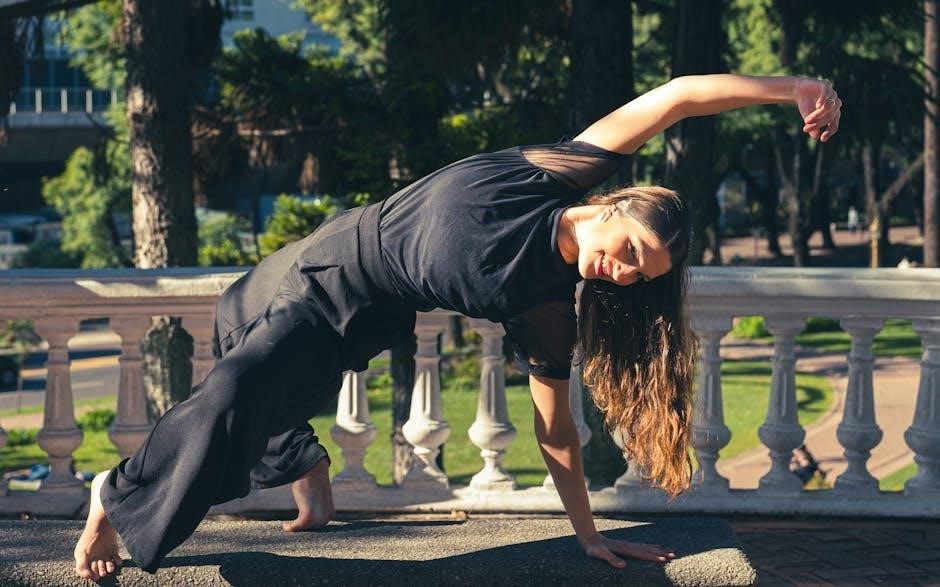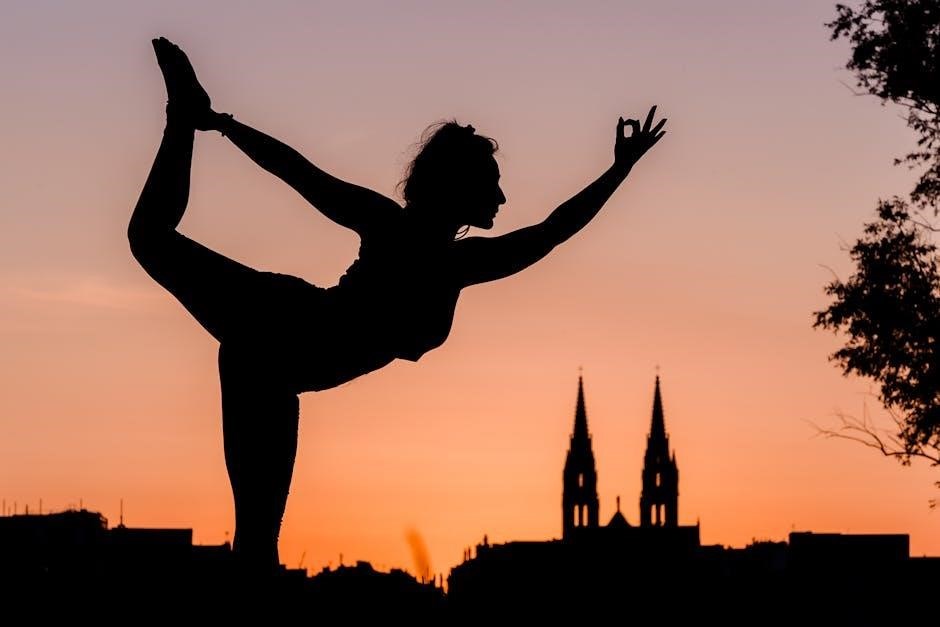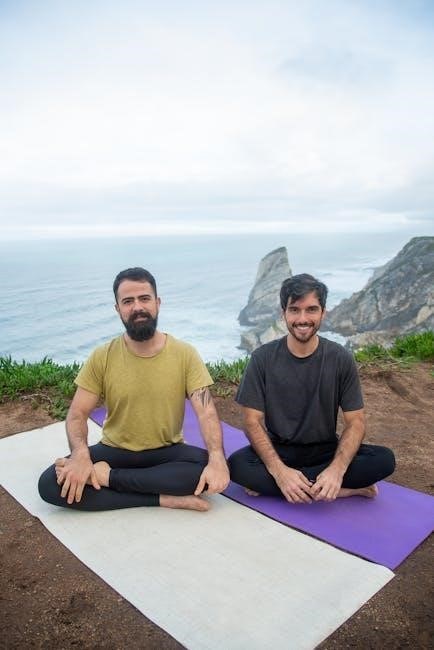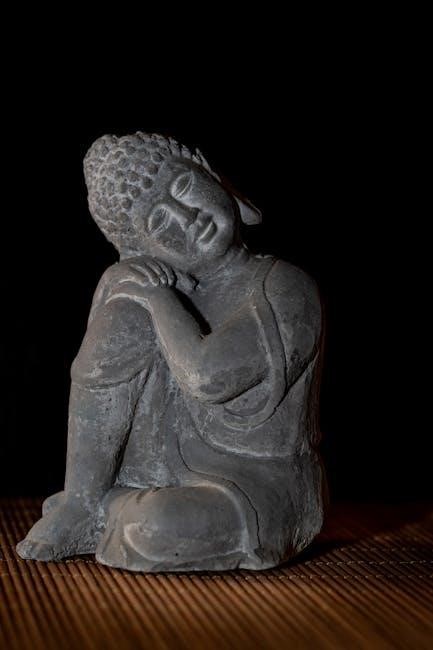Ashtanga Yoga, meaning “Eight Limbs,” is a holistic practice rooted in Patanjali’s Yoga Sutras. It combines physical postures, breath control, and mental disciplines for spiritual growth.
PDF guides like Philippa Asher’s Primary Series and Kino MacGregor’s books offer detailed asana sequences, Vinyasa counts, and philosophical insights, making it accessible for all levels.
These resources provide posture diagrams, mantras, and tips for a traditional practice, helping practitioners deepen their understanding and mastery of this transformative yoga system.
What is Ashtanga Yoga?
Ashtanga Yoga is an eight-limbed holistic practice rooted in Patanjali’s Yoga Sutras, emphasizing ethical living, physical postures, breath control, and meditation. It combines synchronized breathing with progressive asanas to purify the body and mind. PDF guides like Primary Series manuals offer detailed asana sequences, Vinyasa counts, and philosophical insights, aiding practitioners in mastering this transformative system.
Origins and Key Principles
Ashtanga Yoga originates from Patanjali’s Yoga Sutras, outlining an eight-limbed path. Developed by Sri K. Pattabhi Jois, it combines synchronized breath (Vinyasa) with progressive postures, rooted in Krishnamacharya’s teachings. Key principles include nonattachment, self-discipline, and inner awareness. PDF guides detail these origins, emphasizing the integration of physical, mental, and spiritual practices for holistic transformation and self-realization.
History and Evolution of Ashtanga Yoga
Tracing back to Patanjali’s Yoga Sutras, Ashtanga Yoga evolved through Sri K. Pattabhi Jois, who systematized it into a physical practice. PDF guides detail its lineage, preserving Krishnamacharya’s teachings for modern practitioners.
Development by Sri K. Pattabhi Jois
Sri K. Pattabhi Jois developed Ashtanga Yoga, influenced by Krishnamacharya’s teachings. He structured the practice into sequences like Primary Series, focusing on Suryanamaskara, Vinyasa, and breath-synchronized movement. His teachings emphasize physical postures, Bandha, and Drishti, leading to spiritual growth. Jois’s method, detailed in PDF guides, has popularized Ashtanga globally, with resources like practice sheets and eBooks preserving his legacy.
Roots in Krishnamacharya’s Teachings
Krishnamacharya’s teachings deeply influenced Ashtanga Yoga, shaping its foundational principles. He emphasized dynamic asana sequences, breath awareness, and the integration of the eight limbs. PDF resources highlight his legacy, detailing how his methods were passed to Pattabhi Jois, forming the basis of modern Ashtanga practice. These guides provide insights into Krishnamacharya’s philosophy and its enduring impact.
Modern-Day Practice and Popularity
Ashtanga Yoga has gained global popularity for its structured sequences and transformative benefits. Today, practitioners worldwide embrace its traditional Vinyasa system, often guided by downloadable PDFs and online resources. Its accessibility through modern platforms has made it a favorite among enthusiasts, blending physical rigor with mental discipline, appealing to diverse levels of yoga practitioners globally.
The Eight Limbs of Ashtanga Yoga
Ashtanga Yoga, based on Patanjali’s Yoga Sutras, consists of eight limbs: Yamas, Niyamas, Asanas, Pranayama, Pratyahara, Dharana, Dhyana, and Samadhi. These limbs guide practitioners toward self-discipline, inner peace, and spiritual enlightenment, forming a holistic path to balanced living. Downloadable PDF guides detail these principles, offering insights into their practical application and philosophical depth.
Yamas
Yamas are ethical guidelines in Ashtanga Yoga, emphasizing non-violence, truthfulness, and self-control. They form the foundation for a moral life, fostering harmony within and with others. PDF guides like Philippa Asher’s and Kino MacGregor’s books explore these principles, offering practical wisdom for integrating Yamas into daily life.
Niyamas
Niyamas are personal observances fostering self-discipline and inner peace. Practices like cleanliness, contentment, and self-reflection are explored in PDF guides such as Philippa Asher’s and Kino MacGregor’s books. These resources provide insights into integrating Niyamas for mental clarity, emotional balance, and a deeper connection to oneself.
Asanas
Asanas are the physical postures in Ashtanga Yoga, designed to purify and strengthen the body. The Primary Series includes poses like Suryanamaskara (Sun Salutations) and standing postures such as Utthita Trikonasana. PDF guides detail each asana, offering Vinyasa counts and breath synchronization. Resources like Philippa Asher’s sheets and Kino MacGregor’s books provide visual aids for mastering these postures.
Pranayama
Pranayama, the fourth limb of Ashtanga Yoga, involves breath control techniques to balance energy and calm the mind. Practices like Ujjayi (Victorious Breath) and Nadi Shodhana (Alternate Nostril Breathing) are detailed in PDF guides. These resources, such as Kino MacGregor’s books, provide step-by-step instructions and benefits of pranayama for deepening awareness and spiritual growth.
Pratyahara
Pratyahara, the fifth limb of Ashtanga Yoga, involves withdrawing the senses from external distractions to focus inward. This practice cultivates mental clarity and prepares the mind for deeper meditation. PDF guides, such as those by Kino MacGregor, detail techniques to master Pratyahara, emphasizing its role in achieving inner calm and spiritual awareness.
Dharana
Dharana, the sixth limb of Ashtanga Yoga, focuses on concentration and mental focus. It involves fixing the mind on a single point, such as the breath or a mantra, to cultivate mental stability. PDF guides, like those detailing the eight limbs, provide insights into mastering Dharana, essential for progressing toward meditation and deeper states of consciousness.
Dhyana
Dhyana, the seventh limb of Ashtanga Yoga, is the state of meditation where the mind observes a single point without distraction. It transcends concentration (Dharana), leading to a deeper connection with the self. PDF guides on Ashtanga Yoga explain techniques to achieve Dhyana, emphasizing its role in preparing the mind for the final limb, Samadhi, or liberation.
Samadhi
Samadhi, the eighth limb of Ashtanga Yoga, is a state of pure consciousness and liberation, where the individual self merges with the universal. It is the ultimate goal, achieved through dedicated practice, meditation, and self-surrender. PDF resources on Ashtanga Yoga describe Samadhi as the culmination of the Eight-Limbed Path, offering deep insights into its attainment and significance.
The Primary Series of Ashtanga Yoga

The Primary Series of Ashtanga Yoga is a structured sequence of postures synchronized with breath. PDF guides provide detailed Vinyasa counts, illustrations, and insights into this foundational practice, aiding practitioners.
Overview of the Primary Series
The Primary Series, foundational to Ashtanga Yoga, is a sequence of postures synchronized with breath. It begins with Surya Namaskara, followed by standing, seated, and finishing postures. PDF guides, like those from Philippa Asher, detail each asana, Vinyasa counts, and breath techniques, offering a comprehensive roadmap for practitioners to follow traditionally. This structured approach aims to build strength, flexibility, and internal awareness, preparing the body and mind for deeper practices. The series is designed to be learned progressively, with each posture building upon the previous one, fostering a meditative flow that unites breath and movement. These resources are invaluable for both beginners and advanced students, ensuring accurate alignment and understanding of the method as taught by Sri K. Pattabhi Jois.
Key Asanas and Their Benefits
The Primary Series includes foundational poses like Surya Namaskara, Uttanasana, and Chaturanga Dandasana, which build strength and flexibility. PDF guides detail benefits such as improved posture, balance, and detoxification. These asanas prepare the body for deeper practices, fostering physical and mental alignment while enhancing overall well-being through consistent and dedicated practice.
Vinyasa Count and Breath-Synchronized Movement
Ashtanga Yoga emphasizes Vinyasa, a breath-synchronized movement system linking postures. Each asana is held for a specific breath count, fostering internal purification and focus. PDF guides detail sequences like Surya Namaskara A (9 Vinyasas) and B (17 Vinyasas), ensuring precise coordination of breath and movement for a meditative flow and enhanced physical, mental alignment.

Resources for Learning Ashtanga Yoga
Discover comprehensive PDF guides, eBooks, and downloadable Asana practice sheets for Primary, Intermediate, and Advanced series. Online classes and tutorials offer step-by-step instructions, posture diagrams, and breath-synchronized movements, providing accessible learning tools for all levels of Ashtanga Yoga practitioners.
Recommended PDF Guides and eBooks
Explore detailed PDF guides like Philippa Asher’s Primary Series and Kino MacGregor’s books, offering asana sequences, Vinyasa counts, and philosophical insights. eBooks such as “Ashtanga Yoga: Practice and Philosophy” provide posture diagrams, mantras, and tips for a traditional practice. Download these resources from official websites or platforms like Etsy for a comprehensive learning experience.
Downloadable Asana Practice Sheets
Downloadable Asana practice sheets for Ashtanga Yoga are available for the Primary, Intermediate, and Advanced series. These sheets, often created by experienced practitioners like Philippa Asher, include photos, Vinyasa counts, and mantras. They provide a visual and structured guide for home practice, ensuring alignment with traditional methods and sequences. Access them from official websites or platforms like Etsy.
Online Classes and Tutorials
Online classes and tutorials for Ashtanga Yoga are widely available, offering structured lessons for all levels. Platforms provide video tutorials, guided sessions, and interactive workshops. These resources often include downloadable content, such as PDF guides and posture diagrams, to enhance learning. They are ideal for those seeking flexibility and accessible instruction in traditional Ashtanga practices.

Intermediate and Advanced Series
The Intermediate Series (Nadi Shodhana) focuses on cleansing energetic channels, while the Advanced Series (Sthira Bhaga) emphasizes stability and strength. Both build on the Primary Series foundation, offering deeper physical and mental challenges. PDF resources detail postures, breath techniques, and philosophical connections for advanced practitioners seeking progression in their Ashtanga Yoga journey.
Intermediate Series (Nadi Shodhana)
The Intermediate Series, or Nadi Shodhana, is the second series in Ashtanga Yoga, focusing on cleansing the energetic channels. It builds on the Primary Series, introducing more complex postures to balance and strengthen the body. PDF guides, such as those by Philippa Asher, detail the sequence, emphasizing Ujjayi breath, Bandhas, and Drishti for deeper practice intensity and spiritual connection.
Advanced Series (Sthira Bhaga)
The Advanced Series, known as Sthira Bhaga, represents the pinnacle of Ashtanga Yoga, offering highly complex postures. PDF resources, such as manuals by Sharath Jois, provide detailed insights into this series, focusing on intense physical and mental challenges. These guides emphasize mastery of breath, bandhas, and concentration, preparing practitioners for profound meditative states and spiritual awareness.
Key Differences and Progression
The Intermediate Series (Nadi Shodhana) focuses on cleansing energy channels, while the Advanced Series (Sthira Bhaga) emphasizes intense physical and mental challenges. Progression traditionally requires mastery of prior series, not time-based advancement. PDF guides detail asanas, offering insights into the nuanced differences and progression criteria for practitioners seeking to deepen their practice and understanding of Ashtanga Yoga.

Philosophy and Lineage
Rooted in Patanjali’s Yoga Sutras, Ashtanga Yoga emphasizes the Eight-Limbed Path, guiding practitioners toward self-discipline and spiritual awakening. Its lineage traces back to Krishnamacharya, with Sri K. Pattabhi Jois popularizing the system, blending philosophy with precise asana practices to foster holistic transformation.
Patanjali’s Yoga Sutras and the Eight-Limbed Path
Patanjali’s Yoga Sutras outline the Eight-Limbed Path, forming Ashtanga Yoga’s foundation. PDF guides detail this framework, from ethical living (Yamas, Niyamas) to meditation (Dhyana) and union (Samadhi). These texts emphasize the limbs as progressive steps toward self-realization, integrating philosophy with practice for a balanced and enlightened life, as taught by Sri K. Pattabhi Jois and Krishnamacharya.
Lineage and Traditions
Ashtanga Yoga’s lineage traces back to Sage Patanjali, who introduced the Eight-Limbed Path. The tradition was further refined by Sri T. Krishnamacharya and popularized by Sri K. Pattabhi Jois. Guruji and Sharath Jois continue this legacy, emphasizing the importance of preserving the traditional method. Mantras like “Om vande gurunam caranaravinde” reflect its deep spiritual roots and adherence to ancient teachings.
Modern Interpretations and Applications
Modern Ashtanga Yoga blends traditional principles with contemporary approaches. Teachers like Kino MacGregor and David Svenson offer fresh perspectives while honoring the lineage. Digital resources, such as PDF guides and online tutorials, make the practice accessible globally. These interpretations maintain the essence of the Eight-Limbed Path while adapting to diverse student needs and lifestyles today.

Benefits and Tips for Practice
Ashtanga Yoga enhances physical strength, mental clarity, and spiritual awareness. Start with the Primary Series, focus on Vinyasa breath-synchronization, and gradually progress. Regular practice fosters discipline and inner peace, while downloadable PDF guides provide structured support for a transformative journey.
Physical, Mental, and Spiritual Benefits
Ashtanga Yoga enhances physical strength, flexibility, and balance while improving mental focus and reducing stress. Spiritually, it fosters self-awareness and inner peace, guiding practitioners toward enlightenment. PDF guides detail these benefits, offering structured practices to integrate body, mind, and spirit for holistic well-being and transformation.
Tips for Starting Your Ashtanga Yoga Journey
Begin with the Primary Series, focusing on proper Vinyasa and breath synchronization. Use downloadable PDF guides for posture diagrams and sequences. Practice consistently, building gradually as mastery grows. Seek guidance from experienced teachers or online tutorials. Embrace patience and dedication to fully experience the transformative benefits of Ashtanga Yoga.
Ashtanga Yoga’s transformative power lies in its holistic approach. PDF guides offer invaluable resources for practice and understanding, ensuring a deeper connection to this ancient, yet timeless tradition.
Summing Up the Key Points
Ashtanga Yoga is a structured, transformative practice blending physical postures, breath, and mental focus. PDF guides like Philippa Asher’s Primary Series and resources from ranjanayogaclass.com provide detailed insights, sequences, and philosophical foundations. These materials aid practitioners in mastering asanas, understanding Vinyasa counts, and deepening their spiritual connection, making them invaluable for both beginners and advanced yogis alike.
Encouragement for Further Exploration
Embark on a deeper journey with Ashtanga Yoga by exploring comprehensive PDF guides and eBooks. Resources like Philippa Asher’s Primary Series and downloadable practice sheets offer detailed insights, helping you refine your practice. Visit platforms like ranjanayogaclass.com for authentic materials that enrich your understanding and inspire continued growth on this transformative path.
